|
Nie
Mowi po Polsku
- Zamosc & Krakow, Poland
Greetings
and a
dedication to Chris Labak back in Chicago, Czesc!
Poland,
home
of the Pope, who is actually home for the holidays this week, Krakow,
the cultural heart of the country.
The
main activity in Zamosc, a postage stamp sized town, is sitting out in
the main square drinking. It was also here where we discovered how
seriously they also take their religion. While both well-schooled in Roman Catholic tradition, dogma and
ritual, we were more drawn to faith and study in comparitive religions,
leading us to take part in religious celebrations wherever we went, so
long as we were not in offense of anyone. But here in Poland, we were on
home territory. We went to the
Sunday evening 6:00 mass and was surprised to find it
packed.
People who didn't fit inside the church just
sat outside on the
grass following along, not the least bit perturbed.
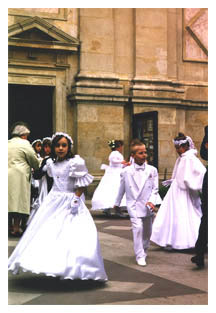 Young
Polish children taking part in the rite of First Communion. Young
Polish children taking part in the rite of First Communion.
Another
interesting point of
the Polish version of
Catholicism.
They keep those priests
working hard during mass. All
during the mass, there
was a line of people on both
sides of the church
confessing continually. They
need
five priests for the
mass, just to keep up with that
volume of sinning.
And finally the communion. We
are
always interested in
how each church handles the
communion because we
know St Ita's at home in Chicago is
a free for all when it comes to scoring the wafer.
But
here in Poland, the priest actually comes to you.
Again
there were five priests wandering around, and
we
waited for them to come to us, but somehow, chalk
it
up to being a foreigner, but we were skipped.
No
communion.
Does that still count as a mass?
Back
to the drinking, which Poles take in equal measure to religion, and no
doubt as comfortable with both, as Irish Catholics partaking in Guiness
in a pub after Sunday mass. Surrounding
the main square are
many outdoor drinking gardens, covered in pretty umbrellas and
substantial furniture. None of
that
plastic resin stuff,
but nice wrought iron and wood
furniture. There were all outdoor taps and at night,
the whole place was
illuminated with soft twinkly
lights. We fell easily into the rythmn.
One drink and
shift, matched in time
with the crowds letting out from the nearby church, on the hour, on the
dot, til we had sampled the beer and ice cream at each pavilion.
A very
restful two days.
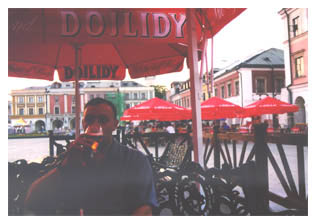
It
was also here in Zamosc that we sampled our first
milk bar, a remnant of
Soviet times. Designed to quickly and cheaply
feed the workers, a few of these places still exist.
In a rather bleak cafeteria, we
walked up to the food
line, and looking at the
different metal pans,
you point at what you want. We pointed a bit too
much and ended up with two heaping trays
of hearty polish food for a few bucks. It was very good actually and quite budget conscious.
But time to move on to
Krakow.

Krakow
boasts a certain vitality that beats throughout
the magnificant old
town and castle. At its
center
is an large public
square called the Rynek that is
wall to wall people,
not just tourists but Poles
themselves which keeps
the city alive. Under the
watchful clock tower in
the center a stage was
assembled and bands
played throughout the days. Stepping
away from this square, you find yourself
wandering down small
cobblestone streets lined with
graceful Renaissance
and Baroque buildings. This town
boasts such a rich cultural heritage, tempered by its recent horrifying
past.
Krakow
was the Nazis northern headquaters, through
which many Jews passed en route to Aushwitz.
Despite
the horror of the war,
Krakow survived intact unlike
its northern
counterpart, Warsaw, which was almost
entirely rebuilt after WWII. Today,
each abandoned
synagogue, Renaissance
arcade, and towering monument
demand attention and
admiration. if only for its
miraculous survival.
Its heart beats on.
Some
highlights of Krakow:
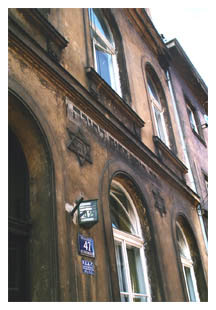 To
engage the past, we visited Kasimierz, the former
Jewish ghetto.
Today, it stands as a mostly deserted
memorial to its former
inhabitants. We visited
the only active synagogue in the area which also
houses a cemetary with
unique above ground coffins
that date from the
fourteenth century. Like
most of
the surviving
synagogues, it was used as a warehouse
for the Nazis.
Many of the surrounding streets were
used in the movie
Shindler's List because they look
much as they did during
WWII. To
engage the past, we visited Kasimierz, the former
Jewish ghetto.
Today, it stands as a mostly deserted
memorial to its former
inhabitants. We visited
the only active synagogue in the area which also
houses a cemetary with
unique above ground coffins
that date from the
fourteenth century. Like
most of
the surviving
synagogues, it was used as a warehouse
for the Nazis.
Many of the surrounding streets were
used in the movie
Shindler's List because they look
much as they did during
WWII.
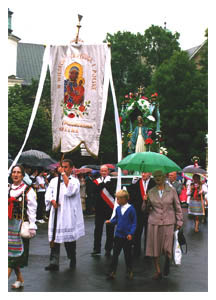 One
day we wandered out and discovered everything
closed.
Turns out it is the Catholic feast of
Corpus Christi (like I
remember all the feast days)
which of course in
Poland, any Catholic holiday is
automatically a
national holiday. We stood
in the
rain
with the other 500,000
Poles along the main road
through town and
watched the procession/parade that
was being put on. One
day we wandered out and discovered everything
closed.
Turns out it is the Catholic feast of
Corpus Christi (like I
remember all the feast days)
which of course in
Poland, any Catholic holiday is
automatically a
national holiday. We stood
in the
rain
with the other 500,000
Poles along the main road
through town and
watched the procession/parade that
was being put on.
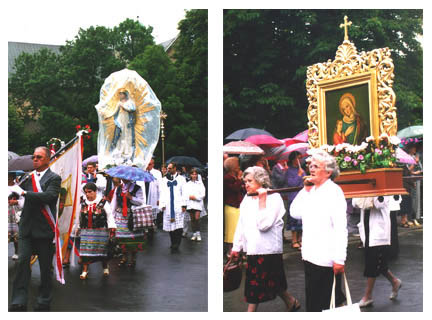
There were beautiful crosses and
other holy paraphenalia. They even brought out a
relic - some saint's finger I believe. The
main pagentry
was followed by a mile
long procession of nuns, monks, friars, and finally
priests. There is certainly
no shortage of young
people rushing to commit themselves to the church.
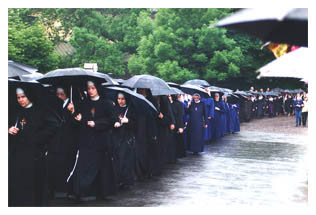
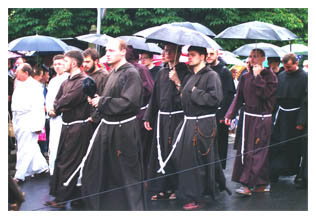
Besides
endlessly wandering the streets of the old town, we sampled perogies and my new favorite dish,
bigos - a stew of
various meats and sauerkraut cooked
til the flavors and
ingredients meld into a rich
concoction. We ate at both milk bars and nice
restaurants, and
sampled ice cream at every stand. Doug highly recommends
the Polish beers, Dojlidy and
Zwiec. The food was just so good, and so heavy.
It fills you and then I
swear, it expands, making
you feel fuller and
lazier as the day progresses.
Two
very noteworthy sidetrips from Krakow.
First
we visited the Wiezlicka Salt Mines, a fully
functioning salt mine
since the thirteenth century. We travelled deep into
the mine, about 475 feet/158
yards or the distance
of a football field and a half
toward the center of
the earth. The mines
actually go more than twice as
deep, but not where the public
can visit.
The mines are considered one of the modern
wonders of the world,
mostly notably for the salt
carvings.
And that is why everyone comes to visit.
Deep within the mines
are hundreds of salt carvings
by miners to creatively
express themselves against the
drudgery of mining. Some are hundreds of years old,
and all are made by
untrained, supposedly unskilled
minors, but the works
themselves prove otherwise.
Within the labyrinth
caverns are stories in salt,
some of myths, other
mining legends, and still others
of a religious nature. There is even a huge cavern
church complete with
salt frescoes, a salt alter,
nativity scene and
replica of Leonardo's last supper.
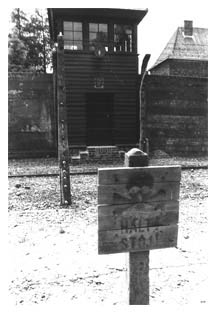 Then
we visited Auchwitz - Berkenau. I
think the
enormity of it all
overwhelmed me. You can
read about
it, and watched movies
about it, but to actually see
it. The full scale of the tragedy becomes
horrifyingly
evident.
Auchwitz today is a museum with exhibits
liberated.
In many ways though, Berkenau, less than a
mile away, is far more terrifying. While
Aushwitz
is
a museum, Berkenau is a concentration camp, left
almost
exactly as it was in 1945, when the Soviets
liberated
the camp. Barracks still stand with the
wooden
bunks and even original drawings on the walls.
Watchtowers rings the camp which is still guarded by
rows
and rows of electrified barb wire. Here,
is
where
the
enormity of the crime becomes apparent. The
fields
are endless. You keep walking and
walking
and
still more rows of barracks.
Finally you get to
the
ruins of the gas chambers and crematoria, which
were
bombed by the fleeing Nazis to try to cover up
their
crimes. But it is still very much
recognizable.
And
you become numb. The evil
is incomprehensible. Then
we visited Auchwitz - Berkenau. I
think the
enormity of it all
overwhelmed me. You can
read about
it, and watched movies
about it, but to actually see
it. The full scale of the tragedy becomes
horrifyingly
evident.
Auchwitz today is a museum with exhibits
liberated.
In many ways though, Berkenau, less than a
mile away, is far more terrifying. While
Aushwitz
is
a museum, Berkenau is a concentration camp, left
almost
exactly as it was in 1945, when the Soviets
liberated
the camp. Barracks still stand with the
wooden
bunks and even original drawings on the walls.
Watchtowers rings the camp which is still guarded by
rows
and rows of electrified barb wire. Here,
is
where
the
enormity of the crime becomes apparent. The
fields
are endless. You keep walking and
walking
and
still more rows of barracks.
Finally you get to
the
ruins of the gas chambers and crematoria, which
were
bombed by the fleeing Nazis to try to cover up
their
crimes. But it is still very much
recognizable.
And
you become numb. The evil
is incomprehensible.
Ending
on a somber note, Poland is a land continually caught up in the old
struggle between east and west. But with a unique
solidarity in the face of
oppression. The land is scarred,
first from the Nazi invasion,
then
from the Soviet Iron
Curtain. In its new independence,
visitors find
themselves affected by the many
juxtapositions, a
morning at a gothic castle, an
afternoon at a
concentration camp. But
just when
you begin to feel
overwhelmed by the history, the
spirit and the
countryside comfort. Endless
rolling
green hills dotted with
farms and striped by even
rows of crops.
Horse carts still make their way alongside speedy cars, and the people live on.
over
and out
ann
and doug
index | back
| next |
